At the woodland’s edge: Restoration and complexity in Colorado’s Piceance Basin
This story was written by our esteemed partners at Intermountain West Joint Venture and also appears on the IWJV website.
On a chilly April morning in the Piceance Basin region of northwest Colorado, two young women stand on an overlook still scattered with snow.
Before their feet the land stretches towards distant mountains—empty, seemingly, but for dry and hardy plants. Shrublands of fragrant sagebrush and bitterbrush, in some spots; and low-lying pinyon pine and juniper trees in others. The land is silent and cold as if waiting for spring.
But the first thing India Barker and Kristin Ross see in this landscape is not emptiness—it’s complexity. A series of puzzles to solve.
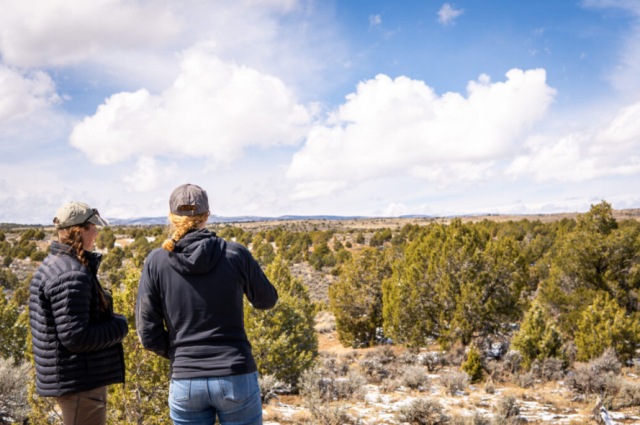
“Historically, these areas were sagebrush parks,” says Barker, gesturing to an area of the landscape that is shrubby and low—mostly devoid of trees. “And that’s super beneficial winter range habitat for mule deer. You have a lot of forbs and grasses in that inner space between the shrubs.”
Mule deer and other big game like elk are not only an indispensable part of the ecosystem in this region of northwest Colorado—they’re a big piece of the local economy.
“Hunting is a huge industry here,” notes Ross. “We rely on those dollars coming in every year.”
Barker nods in agreement.
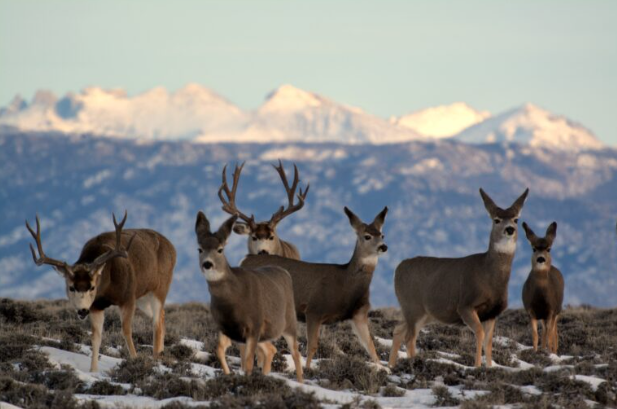
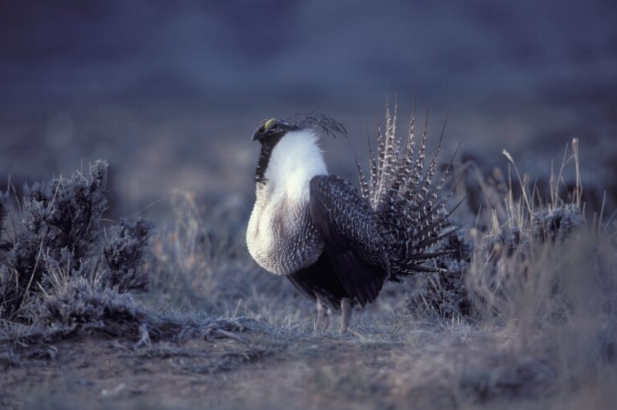
“People call this the Mule Deer Factory of Colorado!” she laughs. It’s an apt title: Mule deer in Rio Blanco County outnumber people by many thousands. They are surely hidden in the landscape here, along with many other creatures that depend on healthy sagebrush habitat—like greater sage-grouse, an enormous and ornate grouse species that is entirely limited to sagebrush.
“If sage grouse are looking out across a sagebrush flat, and they see trees, they’re not going past that line,” explains Barker. “Any line of trees essentially creates a border within their habitat area.”
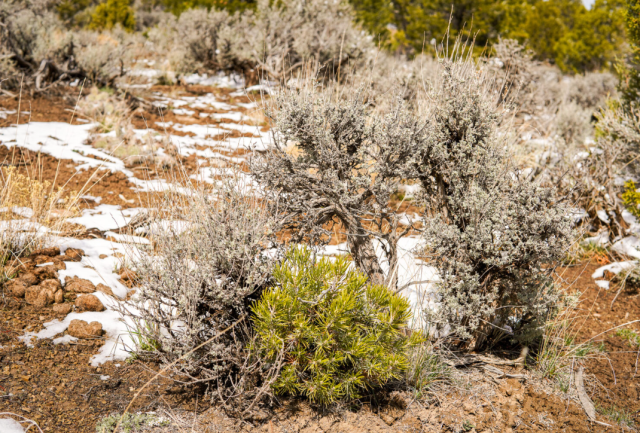
One such “border” is easily visible in the landscape below: A line where shrubs give way to conifers, becoming a woodland. This is the ecotone—a transitional zone between two ecosystems. But looking more closely within the more open areas of sagebrush shrubland, we begin to notice individual trees scattered within.
“What’s happening based on a combination of factors is that those younger conifer trees are encroaching into the sagebrush parks and shading out the understory,” says Barker, pointing to a few spots in the landscape below where the little, isolated trees are numerous. “What you want is a mosaic of sagebrush parks for forage.”
Given enough time, she says, the trees will infill the shrubland entirely.
There is yet more complexity to this habitat problem, though. Not just open sagebrush, slowly-expanding pinyon-juniper woodlands, and species depending on one or the other. Some, Ross notes, rely on the ecotone—the space between.
“Pinyon jays, for example, happen to love the interplay between true pinyon-juniper woodland and that open sagebrush park,” she says. “That gray area is really their bread and butter!”
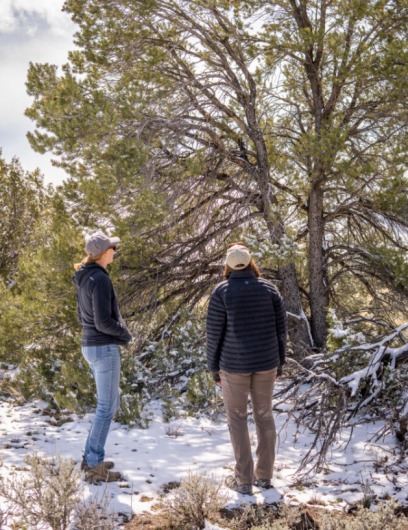
India Barker is the Northwest Colorado Sagebrush Conservation Partnership Coordinator for the Mule Deer Foundation supported by the Intermountain West Joint Venture (IWJV) and the Bureau of Land Management (BLM), and Kristin Ross is a Wildlife Biologist on the local wildfire Fuels Management team with the BLM. Both work extensively here in Rio Blanco County, population just over 6,500. In a place with so few people, those that live here depend fiercely on the land and all that it supports.
Barker and Ross work together closely with partners like Colorado Parks & Wildlife (CPW) to implement habitat treatments that take into account the full complexity of the land and its needs.
“Hopefully over time, the sagebrush parks, pinyon-juniper woodlands, mule deer, elk, sage grouse, and pinyon jays will all benefit from the same type of project…if we design them well,” says Barker.
Fuels for Fire, Fuels for Homes
Primarily, the tool that Barker and Ross’s teams are using to resolve the problem of conifer encroachment is mastication—mechanical removal of selected pinyon and juniper trees.
“Our treatments target those intermediate-age trees out in the sagebrush,” said Ross. “The masticator goes in, the trees get mulched up, and that creates these openings for fresh grasses and forbs to pop up—which are important for big game, but also bring in a vital insect community for birds.”
The mastication process is not only important for sagebrush-dependent species—it’s also a critical tool in this region’s fight against the abnormally intense wildfires that have become more and more common in the West. So while Barker and Ross’s mastication teams enrich habitat, they simultaneously reduce wildfire fuel loads and create fuel breaks.
Catastrophic and unnaturally large wildfires are a serious issue in the Piceance Basin region due to historic fire suppression and more frequent drought, so fire crews need all the help they can get.
“Pinyon-juniper fires are super wind-driven; the flames go from crown to crown and just rip through,” said Barker. “So if you’re able to create a break in these woodlands it can be enough to give fire crews a spot they can work back from to fight fire.”
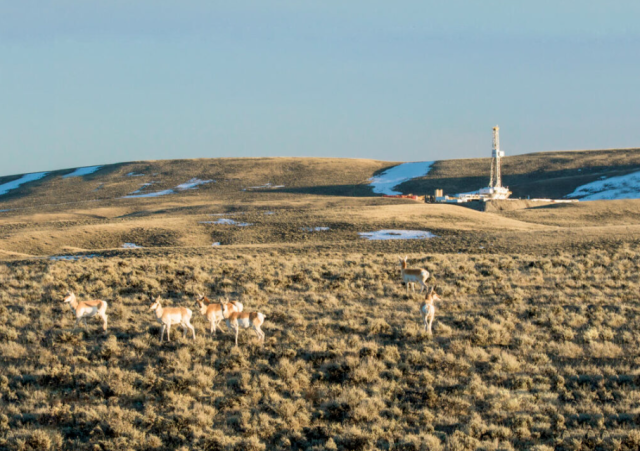
Furthermore, fire crews in the Piceance Basin are tasked with protecting an array of oil and gas infrastructure perched atop the Basin’s estimated 66 trillion cubic feet of natural gas. In 2016 the U.S. Geological Survey estimated this to be the second-largest gas reserve in the country.
“There’s all sorts of infrastructure up there for the oil and gas operations,” notes Barker. “Plants, well pads, tanks, transmission lines, power lines… So if a fire were to rip through uninhibited, it could cause huge destruction.”
Flexibility in Partnership
With a rural economy driven by energy interests, hunting, ranching, and the strength of wildlife habitat, carefully planned habitat management projects can successfully address the needs of recreators, residents, industry, and ecosystems alike. This is where conservation professionals like Barker and other members of the Intermountain West Joint Venture and BLM’s Sage Capacity Team come in. As a project coordinator employed by the nonprofit Mule Deer Foundation who interfaces closely with federal and state agencies, Barker’s position is designed to allow for flexibility and creativity in implementing habitat restoration based on local needs.
“For instance, I’ll often take CPW’s project ideas back to the BLM and vice versa, and then we all work as a team to develop things,” Barker said. “I have the flexibility to go on a ride-along with CPW, see what they’re seeing in the landscape and hear what they’ve got going on—and I’ll do the same with the BLM. All of that falls within my job description.”
Ross noted that Barker’s work has made things easier on the local partnership. “India’s position gives us capacity that we wouldn’t otherwise have,” she said. “For example, I don’t think our staff on our own would have been able to get a current mastication project completed for at least another year without her. Her enthusiasm gets us through it all.”
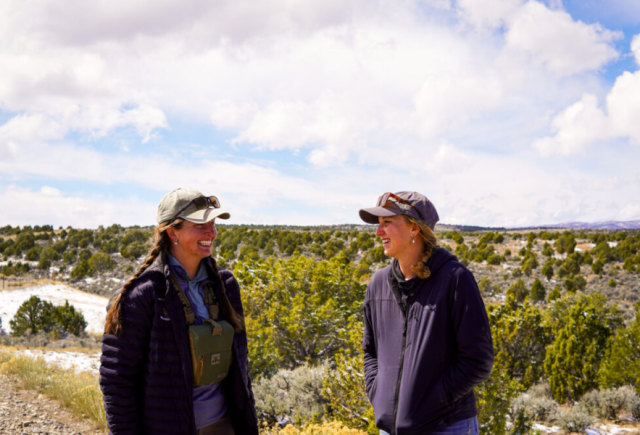
After speaking with Barker and Ross on this snowy hilltop about the breadth of cooperative habitat management projects in the Piceance Basin, the chilly landscape below no longer looks empty. We know there are birds and big game hiding within the sagebrush parks, the woodlands, and the ecotone between; there are oil derricks near the horizon; and there are the people who live off it all. The two women and everyone in their work partnership study the land together, hold the complexity before them, and do their best to move forward.
“It feels like a cheesy thing to say—’Oh, this work benefits everyone,’” says Barker. “But honestly…it’s true. It really does.”
Megan McGrath, Intermountain West Joint Venture
Related Stories
- BLM Fire Team brings Smokey Bear to Kingman’s Street of Lights
- Rural wildland firefighting partners grateful for BLM gift
- BLM hosts fire investigation training course to strengthen wildland fire investigation capacity across Arizona and the West
- Helping Woodlands & Fighting Fire with the Dawson Project
- BLM Fire and National Conservation Lands managers collaborate to meet shared goals
